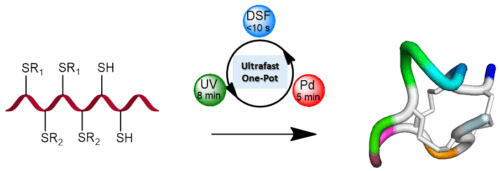After six decades of worldwide effort: success in creating unique proteins with enormous medical implications

The research group of Prof. Ashraf Barik from the Shulich Faculty of Chemistry The Technion reports on a series of breakthroughs in the synthesis of proteins of enormous medical importance. According to Prof. Brick, "2020, which was a particularly difficult year, ended for us with exciting news - approval for the publication of five articles by our research group in the field of biological chemistry, in the same week. These are publications in the world's leading scientific journals, and all deal with the chemical synthesis of proteins and its application in the development of molecules of medicinal importance. We estimate that the new synthesis strategies will greatly help in the production of many drugs for cancer, intestinal diseases, diabetes and other diseases."
The synthesis methods developed by Prof. Barik yield proteins that are important in research and the pharmaceutical industry. These include antimicrobial proteins, which may effectively eliminate bacteria found to be resistant to conventional antibiotics, and hormones such as insulin used to balance blood sugar levels.
One of the five articles was published in the scientific journal Nature Communications. And he presents an innovative chemical method for the creation of peptides with significant medical potential. Peptides are sequences of amino acids, a kind of short proteins, and some of them have been found to be very effective in killing bacteria, viruses and fungi.
Peptides from the plectasins family, characterized by high efficiency in this context, are currently produced from the fungus Pseudoplectania nigrella, but due to their medical potential, a continuous global effort is being made to develop methods for their artificial production (synthesis). In the article in question, the research group from the Technion reports on their first success in doing so. The new technology is based on small molecules, UV radiation and the metal palladium.
The chemical breakthrough in the said research is the creation of peptides containing rings formed through sulfur-sulfur bonds - a synthesis challenge that has occupied many research groups since the first attempt in 1966. The traditional methods for the synthesis of these peptides required a long production time (several days) and many long processes of material isolation The intermediates and cleanings. The result: loss of a lot of material along the way. In addition, these methods were not applicable in the synthesis of other essential protein molecules. The method developed by Prof. Barik's research group takes a few minutes, does not require cleaning of the material in the intermediate stages and most importantly - it does not harm the amino acids in the peptide.
Using the aforementioned method, the group's researchers prepared several challenging peptides containing two or three rings, including a linklutide molecule used in medicines for intestinal problems (sensitive intestine). According to Prof. Brick, "the new method is expected to help a lot in the development of many drugs that the existing synthesis methods did not make it possible to produce. It is about the synthesis of cyclotides relevant to the treatment of cancer and the synthesis of insulin and its derivatives for the treatment of diabetes. Furthermore, the method will enable the rapid production of innovative and specific medicines in the spirit of the medicine of the future - personalized medicine."
Doctoral student Shay Laps (lead author of the article), Master's student Fatma Atamla, Dr. Guy Kaminecki (principal researcher in the laboratory) and Dr. Hao Sun, who was a postdoctoral student in the laboratory and is currently a faculty member at Nanjing University in China, participated in the aforementioned study. The research was supported by the European Union Excellence Grant (Advanced ERC).
More of the topic in Hayadan:
- A new and effective way to create complex proteins
- A new method for making safer medicines
- Separated R.N.A. Tiny and its meaning is about the origin of life
- Anti-hydrogen was captured for the first time in the Axis Particle Accelerator Facility
- A scientist from the Weizmann Institute participates in the selective synthesis of primary amines using a ruthenium catalyst

2 תגובות
To Dror Cohen: The Sages knew everything, everything. They just didn't know how to heal.
Here is another good and positive process that results in them not being
future diseases
As stated by Atzel Chazal